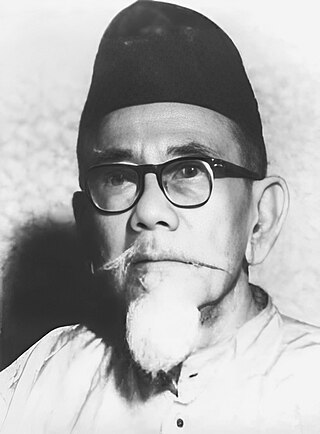
HajiAgus Salim was an Indonesian journalist, diplomat, and statesman. He served as Indonesia's Minister of Foreign Affairs between 1947 and 1949.
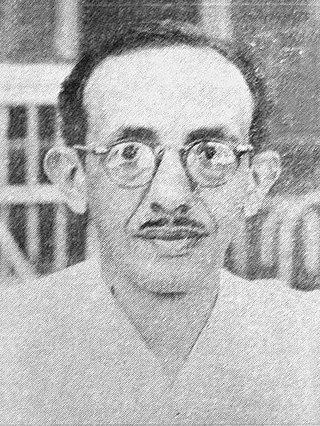
Abdurrahman Baswedan, also known as AR Baswedan was a nationalist, journalist, Indonesian freedom fighter, diplomat, and writer. Baswedan was a member of the Central Advisory Council during the Japanese occupation of the Dutch East Indies and of the Investigating Committee for Preparatory Work for Independence (BPUPK), served as Deputy Minister of Information of the Third Sjahrir Cabinet, a member of the Central Indonesian National Committee Working Group, a member of parliament, and also a member of the Indonesian Constitutional Assembly. Baswedan was one of Indonesia's first diplomats who successfully gained de jure and de facto international recognition for the Republic of Indonesia. He was awarded the title of National Hero of Indonesia in 2018.
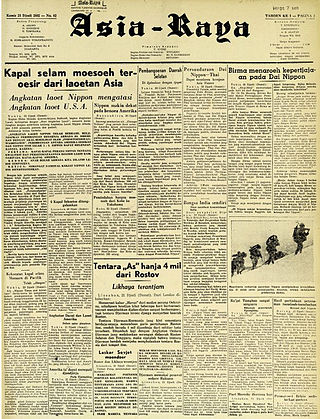
Asia Raya was a newspaper published in the Dutch East Indies during the Japanese occupation.

Terang Boelan is a 1937 film from the Dutch East Indies. Written by Saeroen, directed by Albert Balink, and starring Rd Mochtar, Roekiah and Eddie T. Effendi, Terang Boelan follows two lovers who elope after one is almost forced to marry an opium smuggler. The film was shot in the Indies and Singapore, and was partially inspired by the 1936 Hollywood film The Jungle Princess. It was aimed at native audiences and included keroncong music, which was popular at the time, and several actors from Balink's previous work Pareh (1936).
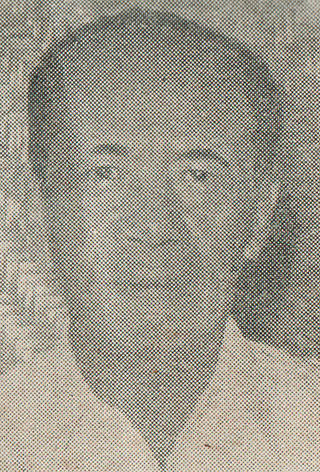
Saeroen was an Indonesian journalist and screenwriter. Born in Yogyakarta, he became a journalist after a time working at a railway station. By the mid-1930s he had established the daily Pemandangan with Oene Djunaedi and was writing editorials with the pen name Kampret. When the paper was dissolved, Saeroen drifted into the film industry as a writer, making his debut with Albert Balink's Terang Boelan (1937). Much of his later life was spent working with several minor publications.

Kedok Ketawa is a 1940 action film from the Dutch East Indies. Union Films' first production, it was directed by Jo An Djan. Starring Basoeki Resobowo, Fatimah, and Oedjang, the film follows a young couple who fight off criminals with the help of a masked man.

Albert Manoempak Sipahoetar was an Indonesian journalist and one of the founders of the state news agency Antara. Born in Tarutung, Dutch East Indies, he took up journalism at an early age and by age 20 had led two publications. After a time working in Medan, he went to the capital at Batavia with Adam Malik. After dabbling in politics and advertising, he established Antara together with three other reporters, heading the agency for a year between 1938 and 1939. Although he remained active as a reporter after leaving the agency, his health failed quickly and he died in a sanatorium near Yogyakarta.

Gagak Item is a 1939 bandit film from the Dutch East Indies directed by Joshua and Othniel Wong for Tan's Film. Starring Rd Mochtar, Roekiah, and Eddy T. Effendi, it follows a masked man known only as "Gagak Item". The black-and-white film, which featured the cast and crew from the 1937 hit Terang Boelan, was a commercial success and received positive reviews upon release. It is likely lost.

Bajar dengan Djiwa is a believed lost 1941 film from the Dutch East Indies. Directed by R Hu and produced by Ang Hock Liem, it starred A Bakar, Djoewariah, O Parma, Oedjang, RS Fatimah, Soelastri, and Zonder. The story centers on two families torn apart by finances and clashes of personality.

Star Film was a film production company in the Dutch East Indies. Established by Chinese-Indonesian businessman Jo Eng Sek and Chinese cameraman Cho' Chin Hsin in 1940, it produced five black-and-white films in 1940 and 1941; two of these were directed by Jo, and the remainder were directed by Wu Tsun. Another film was under production when the studio was closed following the Japanese occupation of the Dutch East Indies. Star helped establish the careers of actors such as S Waldy and Elly Joenara, and produced screenplays written by Rd Ariffien and Saeroen; its output, however, is probably lost.

Parindra was the name used by two Indonesian political parties.

Union Films was a film production company located in Batavia, Dutch East Indies. Established by ethnic Chinese businessmen Ang Hock Liem and Tjoa Ma Tjoen in 1940, it produced seven black-and-white films before it was dissolved in 1942; all are thought to be lost. The company's films were directed by four men, mostly ethnic Chinese, and launched the careers of actors such as Rendra Karno and Djoewariah.

Harta Berdarah is a 1940 action film from the Dutch East Indies. Set in the Middle Ages, the film stars R Sukran and Hadidjah as a pirate and a princess who fall in love. Union Films, the country's first indigenous film production house, produced the film with Rd Ariffien and R Hu as directors. It was written by Saeroen, one of the country's most prolific screenwriters.The film, which stars Zonder and Soelastri, tells of a young man who convinces a stingy hadji to be more charitable and, in the process, falls in love with the man's daughter.
Shigetada Nishijima (西嶋重忠) was a Japanese scholar, former spy and lobbyist. He was active in Indonesia before, during and after the Japanese occupation of the Dutch East Indies, and became a major figure on the Japanese side of the Indonesian National Revolution. Between the 1950s and the 1960s, he was a lobbyist and an intermediary, linking Japanese and Indonesian interests. Later on, he became a scholar of and published memoirs of his time in Indonesia.

Soemanang Soerjowinoto was an Indonesian journalist, politician, and banker.
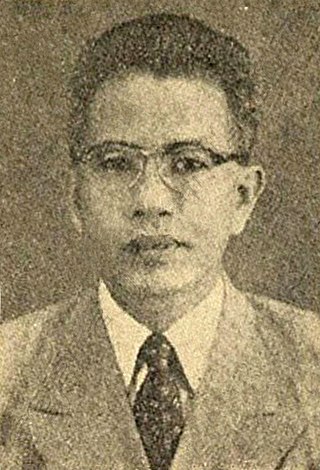
Mohammad Tabrani Soerjowitjitro was an Indonesian journalist and politician. He originated from the island of Madura and received journalistic education in Europe. In his early journalistic career, Tabrani was a major proponent of the Indonesian language as a national language. Later on, he became the editor of the Pemandangan newspaper and promoted the independence of Indonesia through parliamentary means.

Oetarjo Anwar Tjokroaminoto was an Indonesian politician and journalist. He served as Minister of Social Affairs for a year in the Wilopo Cabinet, and was the Prime Minister of Pasundan for less than a month during January 1950.
Asa Bafaqih was an Indonesian journalist, diplomat, and politician. He was best known for being editor-in-chief of the Antara news agency and the Pemandangan newspaper. He also served as ambassador of Indonesia to Sri Lanka and Algeria.

Oene Djoenaidi, better known in Indonesia as R.H.O. Djoenaidi, was an Indonesian businessman. He sponsored the Pemandangan newspaper and was active in early Indonesian press.

















